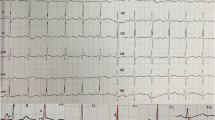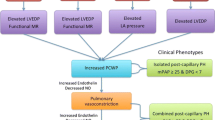Abstract
Background
The prevalence and predictors of atrial tachyarrhythmias (ATa) in patients with pulmonary hypertension (PH) is less well understood.
Methods
We performed a retrospective study including 311 patients with PH, confirmed by right heart catheterization in our center between 2007 and 2011. Baseline characteristics, clinical, echocardiographic, and hemodynamic data were collected and compared between patients with and without ATa.
Results
The mean age was 61 ± 13 years with 64 % females. The mean pulmonary artery pressure (mPAP) was 46 ± 20 mmHg, mean left ventricular ejection fraction (LVEF) was 55 ± 13 %, and mean pulmonary capillary wedge pressure (PCWP) was 19 ± 9 mmHg. Of the 311 patients with PH, 121 (39 %) patients had ATa. Patients with ATa were older (p < 0.001) and were more likely to have systemic hypertension (p = 0.03), diabetes (p = 0.015), coronary artery disease (p < 0.001), heart failure (p < 0.001), mitral regurgitation (p = 0.001), impaired LVEF (p = 0.02), and left atrial enlargement (p < 0.001). There was no difference in the prevalence of ATa in mild, moderate, or severe PH. The mean PCWP was higher in patients with ATa (17.9 ± 9 vs 20.3 ± 8; p = 0.022). In multivariate analysis using Cox-proportional hazard model, the independent predictors of mortality were age (HR 1.05; p = 0.003), coronary artery disease (HR 2.34; p = 0.047), LVEF (HR 0.793; p = 0.023), and mPAP (HR 1.023; p = 0.003).
Conclusion
ATa are common in patients with PH. Left heart disease, left atrial enlargement, and elevated PCWP but not right atrial enlargement or mPAP predict the occurrence of ATa in patients with PH.


Similar content being viewed by others
Abbreviations
- PH:
-
Pulmonary hypertension
- AF:
-
Atrial fibrillation
- SVT:
-
Supraventricular tachycardia
- ATa:
-
Atrial tachyarrhythmia
- LVEF:
-
Left ventricular ejection fraction
- PCWP:
-
Pulmonary capillary wedge pressure
- RHC:
-
Right heart catheterization
- mPAP:
-
Mean pulmonary artery pressure
References
Galie, N., Hoeper, M. M., Humbert, M., Torbicki, A., Vachiery, J. L., Barbera, J. A., et al. (2009). Guidelines for the diagnosis and treatment of pulmonary hypertension: the Task Force for the Diagnosis and Treatment of Pulmonary Hypertension of the European Society of Cardiology (ESC) and the European Respiratory Society (ERS), endorsed by the International Society of Heart and Lung Transplantation (ISHLT). [Practice Guideline]. European Heart Journal, 30(20), 2493–2537.
Simonneau, G., Galie, N., Rubin, L. J., Langleben, D., Seeger, W., Domenighetti, G., et al. (2004). Clinical classification of pulmonary hypertension. [Review]. Journal of the American College of Cardiology, 43(12 Suppl S), 5S–12S.
Nerheim, P., Birger-Botkin, S., Piracha, L., & Olshansky, B. (2004). Heart failure and sudden death in patients with tachycardia-induced cardiomyopathy and recurrent tachycardia. Circulation, 110(3), 247–252.
Chin, K. M., Kim, N. H., & Rubin, L. J. (2005). The right ventricle in pulmonary hypertension. [Comparative Study Review]. Coronary Artery Disease, 16(1), 13–18.
Folino, A. F., Bobbo, F., Schiraldi, C., Tona, F., Romano, S., Buja, G., et al. (2003). Ventricular arrhythmias and autonomic profile in patients with primary pulmonary hypertension. Lung, 181(6), 321–328.
Wensel, R., Jilek, C., Dörr, M., Francis, D. P., Stadler, H., Lange, T., et al. (2009). Impaired cardiac autonomic control relates to disease severity in pulmonary hypertension. European Respiratory Journal, 34(4), 895–901.
Fauchier, L., Babuty, D., Melin, A., Bonnet, P., Cosnay, P., & Fauchier, J. P. (2004). Heart rate variability in severe right or left heart failure: the role of pulmonary hypertension and resistances. European Journal of Heart Failure, 6(2), 181–185.
Cha, Y. M., Redfield, M. M., Shen, W. K., & Gersh, B. J. (2004). Atrial fibrillation and ventricular dysfunction: a vicious electromechanical cycle. [Case Reports Review]. Circulation, 109(23), 2839–2843.
Morillo, C. A., Klein, G. J., Jones, D. L., & Guiraudon, C. M. (1995). Chronic rapid atrial pacing. Structural, functional, and electrophysiological characteristics of a new model of sustained atrial fibrillation. [Research Support, Non-U.S. Gov't]. Circulation, 91(5), 1588–1595.
Tongers, J., Schwerdtfeger, B., Klein, G., Kempf, T., Schaefer, A., Knapp, J. M., et al. (2007). Incidence and clinical relevance of supraventricular tachyarrhythmias in pulmonary hypertension. American Heart Journal, 153(1), 127–132.
Packer, D. L., Bardy, G. H., Worley, S. J., Smith, M. S., Cobb, F. R., Coleman, R. E., et al. (1986). Tachycardia-induced cardiomyopathy: a reversible form of left ventricular dysfunction. The American Journal of Cardiology, 57(8), 563–570.
Clark, D. M., Plumb, V. J., Epstein, A. E., & Kay, G. N. (1997). Hemodynamic effects of an irregular sequence of ventricular cycle lengths during atrial fibrillation. Journal of the American College of Cardiology, 30(4), 1039–1045.
Cha, Y.-M., Redfield, M. M., Shen, W.-K., & Gersh, B. J. (2004). Atrial fibrillation and ventricular dysfunction. Circulation, 109(23), 2839–2843.
Maisel, W. H., & Stevenson, L. W. (2003). Atrial fibrillation in heart failure: epidemiology, pathophysiology, and rationale for therapy. [Review]. American Journal of Cardiology, 91(6A), 2D–8D.
Middlekauff, H. R., Stevenson, W. G., & Stevenson, L. W. (1991). Prognostic significance of atrial fibrillation in advanced heart failure. A study of 390 patients. [Research Support, U.S. Gov't, P.H.S.]. Circulation, 84(1), 40–48.
Rajdev, A., Garan, H., & Biviano, A. (2012). Arrhythmias in pulmonary arterial hypertension. Progress in Cardiovascular Diseases, 55(2), 180–186.
Rottlaender, D., Motloch, L. J., Schmidt, D., Reda, S., Larbig, R., Wolny, M., et al. (2012). Clinical impact of atrial fibrillation in patients with pulmonary hypertension. PLoS One, 7(3), e33902.
Conflict of interest
None relevant to the current study.
Author information
Authors and Affiliations
Corresponding author
Rights and permissions
About this article
Cite this article
Kanmanthareddy, A., Reddy, Y.M., Boolani, H. et al. Incidence, predictors, and clinical course of atrial tachyarrhythmias in patients with pulmonary hypertension. J Interv Card Electrophysiol 41, 9–14 (2014). https://doi.org/10.1007/s10840-014-9928-5
Received:
Accepted:
Published:
Issue Date:
DOI: https://doi.org/10.1007/s10840-014-9928-5




